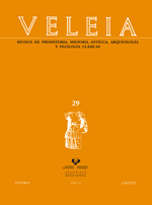The Antique Epigraphic Tradition in Hispanic Inscriptions of the 15th and 16th Centuries
##plugins.themes.bootstrap3.article.main##
##plugins.themes.bootstrap3.article.sidebar##
Abstract
We study the introduction of Humanistic writing in the Spanish Renaissance inscriptions and its development across the various epigraphic programmes during the 15th and 16th centuries. The first signs of the litterae antiquae in Hispanic epigraphy are found in the first Renaissance-style funerary monuments. However, it was soon used in public contexts as a propaganda and self-representation element by the dynasty of the Austrias, as well as some of the nobility, which saw in the recovery of the classical tradition models, a new way of representing power through image and script.
Downloads
##plugins.themes.bootstrap3.article.details##
Unless otherwise noted, the contents of the electronic edition of the OJS platform are licensed for use and distribution under a Creative Commons Attribution-NonCommercial-NoDerivatives 4.0 International (CC-BY-NC-ND) license.
The journal does not charge any financial compensation to authors for publishing in it and provides full access to the archives without any kind of embargo from the day of electronic publication. This respects the national open access policy.
All originals published in the journal Veleia, whether in print or digital format, are the property of the University of the Basque Country (UPV/EHU). © UPV/EHU
Authors of articles (whether research articles, news articles, news items or reviews) will be able to access their own work on the Journal's website. Authors will be able to put them in their personal repositories and will also have the possibility of pre-print dissemination of articles accepted for publication.

